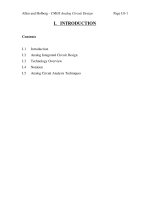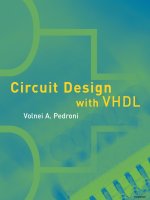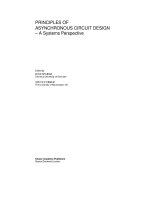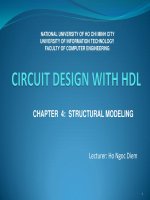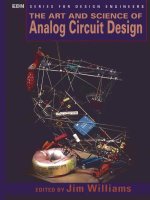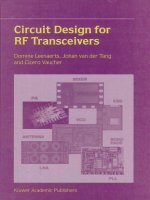Allen and Holberg - CMOS Analog Circuit Design
Bạn đang xem bản rút gọn của tài liệu. Xem và tải ngay bản đầy đủ của tài liệu tại đây (2.11 MB, 477 trang )
Allen and Holberg - CMOS Analog Circuit Design Page I.0-1
I. INT RODUCTION
Contents
I.1 Introduction
I.2 Analog Integrated Circuit Design
I.3 Technology Overview
I.4 Notation
I.5 Analog Circuit Analysis Techniques
Allen and Holberg - CMOS Analog Circuit Design Page I.0-2
Organization
DEVICES
SYSTEMS
CIRCUITS
Chapter 2
CMOS
Technology
Chapter 3
CMOS Device
Modeling
Chapter 4
Device
Characterization
Chapter 7
CMOS
Comparators
Chapter 8
Simple CMOS
Opamps
Chapter 9
High Performance
Opamps
Chapter 5
CMOS
Subcircuits
Chapter 6
CMOS
Amplifiers
Chapter 10
D/A and A/D
Converters
Chapter 11
Analog Systems
SIMPLE
COMPLEX
Introduction
Allen and Holberg - CMOS Analog Circuit Design Page I.2-1
I.1 - INTRODUCTION
GLOBAL OBJECTIVES
• Teach the analysis, modeling, simulation, and design of analog circuits
implemented in CMOS technology.
• Emphasis will be on the design methodology and a hierarchical
approach to the subject.
SPECIFIC OBJECTIVES
1. Present an overall, uniform viewpoint of CMOS analog circuit design.
2. Achieve an understanding of analog circuit design.
• Hand calculations using simple models
• Emphasis on insight
• Simulation to provide second-order design resolution
3. Present a hierarchical approach.
• Sub-blocks
→ Blocks → Circuits → Systems
4. Examples to illustrate the concepts.
Allen and Holberg - CMOS Analog Circuit Design Page I.2-1
I.2 ANALOG INTEGRATED CIRCUIT DESIGN
ANALOG DESIGN TECHNIQUES VERSUS TIME
Requires precise definition
of time constants (RC
products)
FILTERS
AMPLIFICATION
Passive RLC circuits
Open-loop amplifiers
Active-RC Filters
Feedback Amplifiers
Requires precise definition
of passive components
Switched Capacitor
Filters
Requires precise C
ratios and clock
Switched Capacitor
Amplifiers
Requires precise C
ratios
Continuous Time
Filters
Time constants are
adjustable
Continuous Time
Amplifiers
Component ratios
are adjustable
1978
1983
1935-1950
1992
?
?
Digitally assisted analog circuits
Allen and Holberg - CMOS Analog Circuit Design Page I.2-2
DISCRETE VS. INTEGRATED ANALOG CIRCUIT DESIGN
Activity/Item Discrete Integrated
Component Accuracy Well known Poor absolute accuracies
Breadboarding? Yes No (kit parts)
Fabrication Independent Very Dependent
Physical
Implementation
PC layout Layout, verification, and
extraction
Parasitics Not Important Must be included in the
design
Simulation Model parameters well
known
Model parameters vary
widely
Testing Generally complete
testing is possible
Must be considered
before the design
CAD Schematic capture,
simulation, PC board
layout
Schematic capture,
simulation, extraction,
LVS, layout and routing
Components All possible Active devices,
capacitors, and resistors
Allen and Holberg - CMOS Analog Circuit Design Page I.2-3
THE ANALOG IC DESIGN PROCESS
Conception of the idea
Definition of the design
Implementation
Simulation
Physical Verification
Parasitic Extraction
Fabrication
Testing and Verification
Product
Comparison
with design
specifications
Comparison
with design
specifications
Physical Definition
Allen and Holberg - CMOS Analog Circuit Design Page I.2-4
COMPARISON OF ANALOG AND DIGITAL CIRCUITS
Analog Circuits Digital Circuits
Signals are continuous in amplitude
and can be continuous or discrete in
time
Signal are discontinuous in
amplitude and time - binary signals
have two amplitude states
Designed at the circuit level Designed at the systems level
Components must have a continuum
of values
Component have fixed values
Customized Standard
CAD tools are difficult to apply CAD tools have been extremely
successful
Requires precision modeling Timing models only
Performance optimized Programmable by software
Irregular block Regular blocks
Difficult to route automatically Easy to route automatically
Dynamic range limited by power
supplies and noise (and linearity)
Dynamic range unlimited
Allen and Holberg - CMOS Analog Circuit Design Page I.3-1
I.3 TECHNOLOGY OVERVIEW
BANDWIDTHS OF SIGNALS USED IN SIGNAL PROCESSING
APPLICATIONS
10
1 100
1k
10k 100k 1M
10M 100M
1G 10G 100G
Seismic
Sonar
Audio
Video
Acoustic
imaging
Radar
AM-FM radio, TV
Telecommunications Microwave
Signal Frequency (Hz)
Signal frequency used in signal processing applications.
Allen and Holberg - CMOS Analog Circuit Design Page I.3-2
BANDWIDTHS THAT CAN BE PROCESSED BY PRESENT-
DAY TECHNOLOGIES
Frequencies that can be processed by present-day technologies.
101 100 1k 10k 100k 1M 10M 100M 1G 10G 100G
Signal Frequency (Hz)
GaAs
Optical
MOS digital logic
Bipolar digital logic
Bipolar analog
MOS analog
BiCMOS
Allen and Holberg - CMOS Analog Circuit Design Page I.3-3
CLASSIFICATION OF SILICON TECHNOLOGY
Silicon IC Technologies
Bipolar Bipolar/MOS
MOS
Junction
Isolated
Dielectric
Isolated
CMOS
PMOS
(Aluminum
Gate)
NMOS
Aluminum
gate
Silicon
gate
Aluminum
gate
Silicon
gate
Allen and Holberg - CMOS Analog Circuit Design Page I.3-4
BIPOLAR VS. MOS TRANSISTORS
CATEGORY BIPOLAR CMOS
Turn-on Voltage 0.5-0.6 V 0.8-1 V
Saturation Voltage 0.2-0.3 V 0.2-0.8 V
g
m
at 100µA
4 mS 0.4 mS (W=10L)
Analog Switch
Implementation
Offsets, asymmetric Good
Power Dissipation Moderate to high Low but can be large
Speed Faster Fast
Compatible Capacitors Voltage dependent Good
AC Performance
Dependence
DC variables only DC variables and
geometry
Number of Terminals 3 4
Noise (1/f) Good Poor
Noise Thermal OK OK
Offset Voltage < 1 mV 5-10 mV
Allen and Holberg - CMOS Analog Circuit Design Page I.3-5
WHY CMOS???
CMOS is nearly ideal for mixed-signal designs:
• Dense digital logic
• High-performance analog
DIGITAL ANALOG
MIXED-SIGNAL IC
Allen and Holberg - CMOS Analog Circuit Design Page I.4-1
I.4 NOTATION
SYMBOLS FOR TRANSISTORS
Drain
Gate
Source/bulk
Drain
Gate
Source
Bulk
n-channel, enhance-
ment, V
BS
≠
0
n-channel, enhance-
ment, bulk at most
negative supply
Drain
Gate
Source/bulk
Drain
Gate
Source
Bulk
p-channel, enhance-
ment, V
BS
≠
0
p-channel, enhance-
ment, bulk at most
positive supply
Allen and Holberg - CMOS Analog Circuit Design Page I.4-2
SYMBOLS FOR CIRCUIT ELEMENTS
+
-
A V
+
-
G V
R I
I
A I
+
-
m 1
1
V
1
v 1
I
1
V
1
m 1
i 1
V
I
Operational Amplifier/Amplifier/OTA
VCVS VCCS
CCVS CCCS
Allen and Holberg - CMOS Analog Circuit Design Page I.4-3
Notation for signals
I
D
I
d
i
d
i
D
time
Allen and Holberg - CMOS Analog Circuit Design Page II.0-1
II. CMOS TECHNOLOGY
Contents
II.1 Basic Fabrication Processes
II.2 CMOS Technology
II.3 PN Junction
II.4 MOS Transistor
II.5 Passive Components
II.6 Latchup Protection
II.7 ESD Protection
II.8 Geometrical Considerations
Allen and Holberg - CMOS Analog Circuit Design Page II.0-2
Perspective
DEVICES
SYSTEMS
CIRCUITS
Chapter 2
CMOS
Technology
Chapter 3
CMOS Device
Modeling
Chapter 4
Device
Characterization
Chapter 7
CMOS
Comparators
Chapter 8
Simple CMOS
Opamps
Chapter 9
High Performance
Opamps
Chapter 5
CMOS
Subcircuits
Chapter 6
CMOS
Amplifiers
Chapter 10
D/A and A/D
Converters
Chapter 11
Analog Systems
SIMPLE
COMPLEX
Allen and Holberg - CMOS Analog Circuit Design Page II.0-3
OBJECTIVE
• Provide an understanding of CMOS technology sufficient to enhance
circuit design.
• Characterize passive components compatible with basic technologies.
• Provide a background for modeling at the circuit level.
• Understand the limits and constraints introduced by technology.
Allen and Holberg - CMOS Analog Circuit Design Page II.1-1
II.1 - BASIC FABRICATION PROCESSES
BASIC FABRTICATION PROCESSES
Basic Steps
• Oxide growth
• Thermal diffusion
• Ion implantation
• Deposition
• Etching
Photolithography
Means by which the above steps are applied to selected areas of the silicon
wafer.
Silicon wafer
0.5-0.8 mm
125-200 mm
n-type: 3-5 Ω-cm
p-type: 14-16 Ω-cm
Allen and Holberg - CMOS Analog Circuit Design Page II.1-2
Oxidation
The process of growing a layer of silicon dioxide (SiO
2
)on the surface of a
silicon wafer.
Original Si surface
0.44 tox
tox
Si substrate
SiO
2
Uses:
• Provide isolation between two layers
• Protect underlying material from contamination
• Very thin oxides (100 to 1000 Å) are grown using dry-oxidation
techniques. Thicker oxides (>1000 Å) are grown using wet oxidation
techniques.
Allen and Holberg - CMOS Analog Circuit Design Page II.1-3
Diffusion
Movement of impurity atoms at the surface of the silicon into the bulk of
the silicon - from higher concentration to lower concentration.
Low
Concentration
High
Concentration
Diffusion typically done at high temperatures: 800 to 1400 °C.
Infinite-source diffusion:
N(x)
Depth (x)
ERFC
t1<t2<t3
t1
t2
t3
N
B
N
0
Finite-source diffusion:
Depth (x)
t1<t2<t3
t1
t2 t3
Gaussian
N(x)
N
B
N
0
Allen and Holberg - CMOS Analog Circuit Design Page II.1-4
Ion Implantation
Ion implantation is the process by which impurity ions are accelerated to a
high velocity and physically lodged into the target.
Fixed atoms
Path of impurity atom
Impurity final resting place
• Anneal required to activate the impurity atoms and repair physical
damage to the crystal lattice. This step is done at 500 to 800 °C.
• Lower temperature process compared to diffusion.
• Can implant through surface layers, thus it is useful for field-threshold
adjustment.
• Unique doping provile available with buried concentration peak.
N(x)
N
Depth (x)
0
Concentration
peak
B
Allen and Holberg - CMOS Analog Circuit Design Page II.1-5
Deposition
Deposition is the means by which various materials are deposited on the
silicon wafer.
Examples:
• Silicon nitride (Si
3
N
4
)
• Silicon dioxide (SiO
2
)
• Aluminum
• Polysilicon
There are various ways to deposit a meterial on a substrate:
• Chemical-vapor deposition (CVD)
• Low-pressure chemical-vapor deposition (LPCVD)
• Plasma-assisted chemical-vapor deposition (PECVD)
• Sputter deposition
Materials deposited using these techniques cover the entire wafer.
Allen and Holberg - CMOS Analog Circuit Design Page II.1-6
Etching
Etching is the process of selectively removing a layer of material.
When etching is performed, the etchant may remove portions or all of:
• the desired material
• the underlying layer
• the masking layer
Important considerations:
• Anisotropy of the etch
A = 1 -
lateral etch rate
vertical etch rate
• Selectivity of the etch (film toomask, and film to substrate)
S
film-mask
=
film etch rate
mask etch rate
Desire perfect anisotropy (A=1) and invinite selectivity.
There are basically two types of etches:
• Wet etch, uses chemicals
• Dry etch, uses chemically active ionized gasses.
Mask
Film
b
Underlying layer
a
c
Allen and Holberg - CMOS Analog Circuit Design Page II.1-7
Photolithography
Components
• Photoresist material
• Photomask
• Material to be patterned (e.g., SiO
2
)
Positive photoresist-
Areas exposed to UV light are soluble in the developer
Negative photoresist-
Areas not exposed to UV light are soluble in the developer
Steps:
1. Apply photoresist
2. Soft bake
3. Expose the photoresist to UV light through photomask
4. Develop (remove unwanted photoresist)
5. Hard bake
6. Etch the exposed layer
7. Remove photoresist
